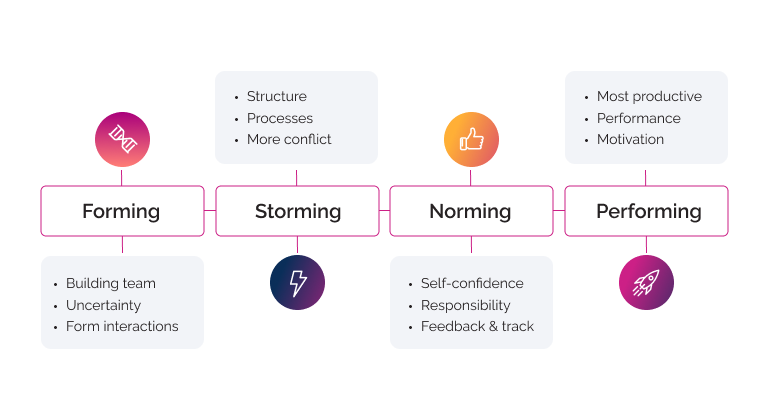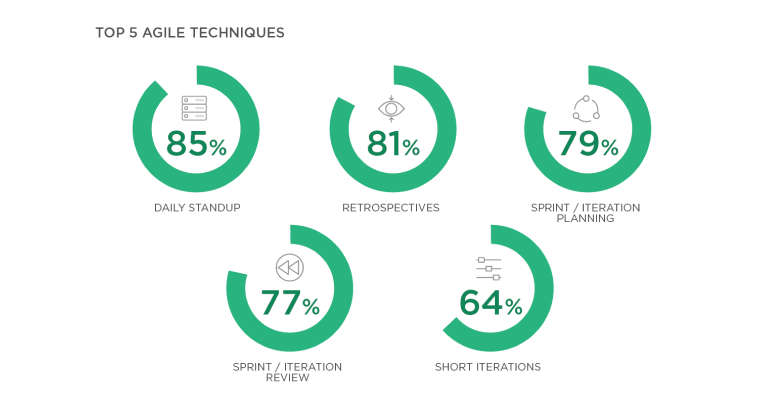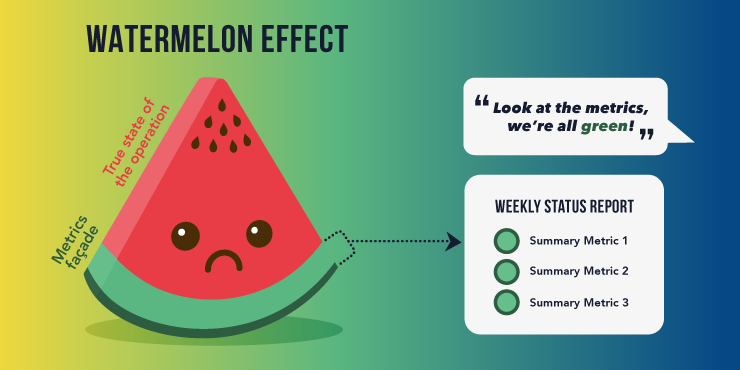What makes high-performing development teams stand apart from the rest? How can you get the most from your team, while also looking out for their needs and concerns?
Effective management is the key to unlocking your development team`s full potential!
In this article, we`ll explore five key strategies you can use to build, lead, and nurture strong software engineering teams from the ground up.
The stages of team evolution
To support and manage your development team, firstly, you need to understand where you stand. Tuckman`s model describes several stages any group goes through, which can also be applied to software engineering teams:
-
Forming: In this stage, you are actively building your development team. Uncertainty and confusion are expected. Thus, you need to focus on ways to integrate team members and nurture interactions.
-
Storming: This stage occurs as tasks and processes become more structured and organized. This might surface some conflict, so it`s important to align on goals, discuss concerns, and come up with ways to tackle challenges.
-
Norming: At this point, the team becomes more self-confident and team members are taking on more responsibility. Constructive feedback, tracking performance, and measuring productivity are key here.
-
Performing: This is the peak stage for your development team and the most productive one. Focus on ways to motivate team members and recognize their hard work to keep them performing at their best.

Tuckman later added a fifth stage to his model called Adjourning. In this last step, members are ready to leave, which can cause a restructuring of the team. While this step is outside the scope of the article, it`s worth noting that proper offboarding can prevent productivity gaps at the end of the project.
Let`s look closer now at how to overcome the challenges associated with each stage and achieve the highest performance for your team.
1. Build a high-performing development team
Commit to a strategy for hiring the right talent
Effective management starts with building the right team. The success of your project depends not only on how skilled team members are but also on how well they fit with your way of doing things.
A comprehensive hiring strategy relies on:
-
A solid understanding of the entire context, including technologies, methodologies, stakeholders, and team structure.
-
An interview plan for assessing technical skills, soft skills, and how well candidates align with your culture and values.
-
A well-documented onboarding process that allows new team members to get up to speed and understand how you work.
Hiring technical talent comes with certain particularities, so it`s important to tailor your approach. For example, software developers have a more dynamic job search experience. This might require you to target them across multiple channels, including social media, paid ads, or referral programs.
In the article “How to Hire Software Developers Like a Pro: ETEAM's Approach”, we go in-depth into ways to attract and hire high-performing talent.
Work with a dedicated development team
According to a McKinsey report, high-performing teams are 56% more productive compared to low-commitment ones. However, it`s not just expertise or culture fit that matters, but also the type of team.
Dedicated development teams, where members commit exclusively to one project, can encourage deep work, a better understanding of requirements, and, as a result, faster problem-solving.
Consider working with a dedicated software team if your project requires long-term development or has complex specifications that need additional focus. Outsourcing to a dedicated team may also provide you with the same level of commitment as an in-house team working exclusively on your project.
Nurture team dynamics
Open communication, as well as clear roles, responsibilities, and expectations, are at the heart of good team dynamics. Address sensitive matters in 1 : 1 meetings, but also make a point of sharing information publicly as much as possible.
In addition to regular team meetings, set up channels where all team members can discuss decisions and share concerns.
If you manage a remote development team, consider putting in place communication protocols so that everyone can keep in touch regardless of time zone. These may include:
-
Agreeing on an average response time for emails and chat messages
-
Limiting messages in chat channels to overlapping hours
-
Avoiding scheduling conflicts to ensure everyone`s time is respected
Clear responsibilities and transparent expectations are also essential for a healthy team dynamic. Each team member should know what is expected from them, including how they will be evaluated.
If certain work needs to be temporarily delegated, for example, a senior developer assisting in scope management, it should be made very clear who is responsible for what and for how long.
Encourage learning and knowledge-sharing
When team members are encouraged to share their expertise and experience everyone has to benefit. Junior developers can learn from senior colleagues and new team members can be onboarded faster, with less time and resources required to bring them up to speed.
Working together to solve complex technical issues also becomes easier and potential risks are mitigated. For example, if one team member leaves or is unavailable, others can quickly step in.
Similarly, knowledge-sharing and proper documentation processes reduce the risk of critical information being lost, including any lessons learned from previous projects. Use post-implementation reviews and centralized knowledge repositories to capture insights and best practices from the projects you manage.
2. Implement project management best practices
Stick to a software development methodology
Software development methodologies provide developers and project managers with the structure and guiding principles they need to deliver quality work. Agile is one of the most popular choices among development teams, focusing on rapid iteration and continuous improvement. Work is broken down into manageable tasks delivered each sprint, allowing teams to build and test incrementally.
There are a lot of variations of Agile, including Scrum, Kanban, Extreme Programming (XP), and Feature-Driven Development (FDD). Each comes with its own focus and emphasis, but ultimately they all rely on a set of key Agile practices.
Agile techniques like daily stand-up meetings, sprint planning, and sprint retrospectives, can improve communication in development teams, boost performance, and allow you to proactively address issues. These tools and techniques empower teams to quickly adapt to changing circumstances and make the real-time management of development projects easier.
Even when talking about managing change, consistency is still important. Regardless of the approach you choose, commit to it both in theory and in practice. Avoid swapping approaches frequently or mid-project, otherwise, your team will never get accustomed to the structure you are trying to create.

Source: 14th Annual State of Agile Report
Provide enough information and align on goals
Documentation is important for keeping everyone moving towards the same goal. Make sure to allocate enough time and resources for the requirements-gathering phase. Involve all key stakeholders when discussing and agreeing on requirements to avoid scope creep or hidden costs later on.
While it`s essential to provide team members with enough context, don`t sacrifice development in favor of comprehensive documentation. Aim for just the right amount of information to get the job done and be ready to answer any additional questions when needed.
As work moves forward, check if the team is still aligned with the initial goals and objectives or if adjustments need to be made. Agile stand-up meetings are a great opportunity to address daily concerns, while retrospectives give you a broader view of the direction you are moving in.
By alternating between these micro and macro perspectives, project managers can address immediate issues and plan accordingly.
Focus on effective task and time management
Missed milestones and unhappy teams are usually the result of inefficient task and time management. Use project management software to keep track of tasks, assignments, and progress. Some of these tools also come with features like Gantt charts, that allow you to visualize dependencies and timelines.
Avoid frequent task switching or excessive multitasking which might confuse developers and push to unblock work rather than add more responsibilities.
Make sure to monitor the workload to avoid the risk of assigning too many tasks to the same people. To make this easier, put in place standards for creating tickets. For example, each ticket should have a clear owner responsible for its completion and a set of acceptance criteria.
Last but not least, avoid team burnout by prioritizing work based on importance and urgency. Support developers with enough information so they can accurately estimate how much time a task will take as this will lead to more realistic milestones.
3. Learn how to handle challenges
Identify blockers early on
There`s no worse feeling for a development team than when the project gets stuck. As deadlines are approaching, it can become increasingly frustrating and time-consuming to figure out what`s wrong. An important part of successfully managing development teams is to recognize blockers early on and remove them before they become show-stoppers.
These obstacles can come in different shapes and sizes, from the lack of proper infrastructure to bugs and errors that send developers back to the drawing board.
One of the biggest responsibilities of a project manager is to ensure that everyone in the team can accomplish their tasks as smoothly as possible. If you want to learn more about key blockers affecting development teams and how to overcome them, make sure to also check out our article on “How to Solve Blockers Slowing Down Your Development Team”.
Expect and prepare for change
At some point in the development process, priorities and requirements might change. Development teams need to be flexible enough to handle shifts in direction without going completely off track.
This is where change management comes in. Expecting and planning for changes in workload, features, and even team structure ensures that all alterations are controlled and communicated properly.
An Agile approach can help your development team react faster to new challenges. Because work is delivered incrementally, changes can be made midway through a project without the same disruptive impact.
In Agile, change is not only expected, it`s welcomed as a way to learn and improve existing processes and deliverables.
Handle conflict the right way
Different work styles, a breakdown in communication, or even a simple misunderstanding can sometimes spark conflict. Your first reaction might be to shut it down as quickly as possible, but conflict can make development teams stronger if handled right.
Disputes allow team members to explore ways of thinking different from theirs and to work together to reach an agreement.
Of course, you need to carefully assess if the conflict is hurting the team or if it leads to a constructive outcome.
4. Measure productivity and track progress
Assess outcomes, not outputs
When measuring your team`s productivity or progress it`s important to also look at outcomes, not just quantitative KPIs. Lines of code and the number of commits allow you to track activity, but they tell you little about the quality of the outcome.
Does the work lead to increased user satisfaction, less code that needs to be rewritten, or more successful deployments?
Focusing exclusively on the output runs the risk of pushing developers to write useless code to meet their quota. This can create a demotivated team and more technical debt down the road.

Source: oldstreetsolutions.com
Conduct one-on-one reviews
Use one-on-one performance reviews to identify strengths and weaknesses within your team. By conducting regular meetings, you can understand potential challenges team members face, give constructive feedback, and set appropriate goals.
These reviews also provide an opportunity to recognize exceptional contributions and discuss career growth plans with high-achieving team members.
Build a continuous feedback loop
The importance of continuous feedback cannot be overstated when it comes to tracking performance and progress.
Otherwise, how will you know what needs to be corrected?
By continuously gathering feedback, evaluating it, and acting upon it, you can understand if team members are moving in the right direction.
The more people are involved in a project, the more you need to optimize feedback loops. Facilitate communication between developers and stakeholders by establishing a two-way route: distill information from stakeholders to your technical team and move input from developers up the chain.
Giving a voice to valuable insights from developers is just as important as providing them with constructive feedback.
5. Motivate your development team
Recognize strengths and reward achievements
Each team member has unique skills and qualities. Acknowledge their strengths by assigning tasks that align with their expertise and empower them to excel in their respective fields. This is particularly important in software development where programming languages and technologies evolve at a fast pace.
To motivate your development team, create an environment where hard work is recognized and rewarded, both by management and by colleagues. Peer recognition tools are a great way for developers to endorse each other's technical skills and show appreciation for team members who helped them navigate difficult tasks.
A Harvard Business School study found that peer feedback and recognition can have a significant impact on motivation and performance.
Support professional growth
Developers often feel the pressure of having to keep up with countless new technologies and tools. More than half of developers surveyed in the 2022 State of Software Engineers report said they are worried their skills are becoming less relevant.
Investing in training, workshops, and certifications can motivate development teams and reassure them their professional growth is a top priority for your organization.
Cultivate a sense of ownership and accountability
Giving teams enough autonomy is a crucial factor in motivating developers to take ownership of their work. A good balance between constraint and freedom has been proven to foster creativity and, as a result, better technical solutions.
Focus on involving team members in the decision-making process. Developers who have a say in things like methodologies, tools, and overall vision are more likely to be involved in the success of the project.
Overseeing a development team comes with its own challenges, including the temptation to micromanage. This is when building a culture of trust and accountability can really make a difference. One of the best approaches is to give developers enough information and adequate directions so they can accomplish a task with minimum supervision.
Conclusion
Whether you are just building your software developer team or moving ahead at full speed, you can use the strategies in this article to assist you. Creating the right environment for high-performing development teams starts with effective management.
A good culture fit, solid communication, clear processes, and rewarding achievements are only a few of the ways you can transform a group of experts into a tight-knit, productive team.








